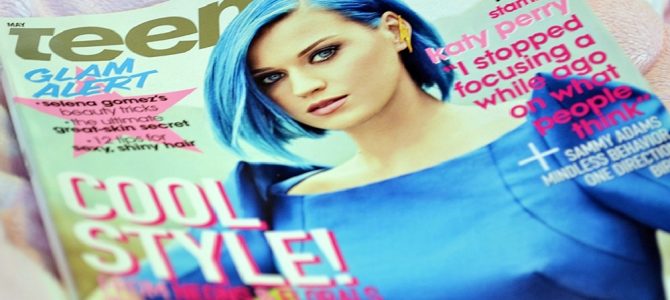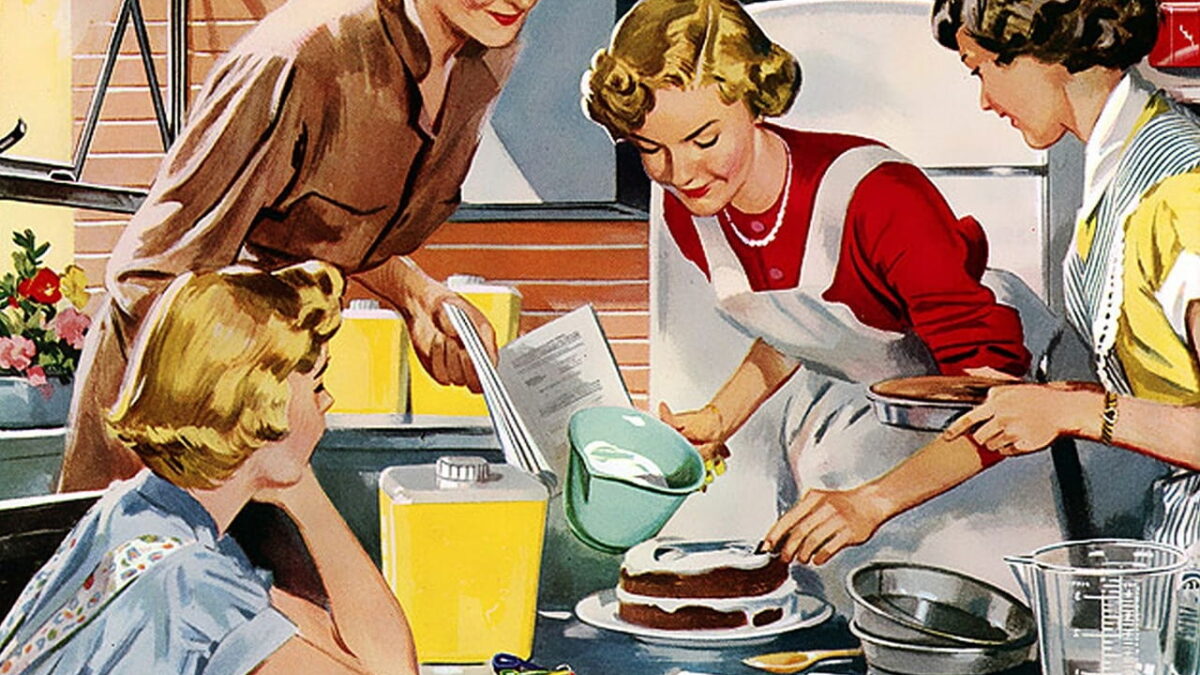
Adult content warning.
While many people joke that no one reads Playboy for the articles, the same is often true for women’s and girl’s themed magazines. Women aren’t consuming magazines for the literary content any more than men are — they’re reading them for the gorgeous and escapist images.
Advertisers know this, and it’s why ad space is sold for so much money in these publications. Heavily airbrushed images of impossibly beautiful people wearing lovely and fantastically expensive clothes in exotic locales have been a mainstay of women’s magazine ads for decades, and it’s no surprise that this, with slight shifts to meet the demographics, holds true in teen girl-themed publications too.
Women possess a large share of the purchasing power in America, and the apparel business in America is a $12 billion dollar a year industry. Everyone wants a bite of that pie, and getting in front of people is the way to vie for their money. Women’s publications know that they can publish subversive and trashy content, as long as they keep it interspersed with the appealing and pretty pictures women really want to see. That’s the content that truly matters, and this what conservative ventures into magazines for women have failed to understand and capitalize on.
Seventeen magazine has angered former subscribers and parents by tweeting a vulgar (seriously, be forewarned and careful who is looking at your screen) and detailed manicure of an anatomically correct woman’s vulva. If this sounds outlandish and bizarre, it’s because it is. This is part of a whole article about politicized manicures, featuring gems such as “fake news,” “R.I.P. Trump,” “R.I.P. Alex Jones,” and then, because why not, a whole article on why, “Boob Nails Are the Feminist Trend You Need.”
None of this is necessary for a magazine aimed at teenagers — their target audience is girls, aged 13–19 — and it’s certainly not appropriate. It’s not surprising, though, for anyone who has been following the troubling trajectory and slipping scope of magazines like Teen Vogue and Seventeen, with their increasing focus on adult themed content and politics.
This mission drift doesn’t come out of nowhere, though. Teen Vogue, owned by Conde Nast, came under intense scrutiny last year for publishing a detailed guide for teenagers on sodomy, called, “Anal Sex: What You Need To Know.” Teen Vogue also has a gift guide for the teenager who is confused on what gift is the exact right choice to give a friend after an abortion, since that’s something Miss Manners never covered in any of her many gift suggestion categories. Seventeen, for its part, under their “Sex Health” category, has an article where, “5 Girls Explain Why They Chose Abortion,” making sure to note that, “The decisions weren’t easy, but they were right in the long run.”
Seventeen is a Hearst Corporation publication, along with Cosmopolitan, Marie Claire, and Elle. Hearst Communications is a privately owned company, and a subsidiary of the Hearst Corporation. This is one of America’s oldest media corporations, and was founded in 1887 by William Hearst.
Publications have to carefully weigh their content against the values and morals of their advertisers. It’s not uncommon for advertisers to pull funding when a star heading a campaign is accused of sexual misconduct or arrested for a particularly unsavory crime, nor is it unheard of for funding to suddenly vanish when someone develops a political opinion that doesn’t mesh with an organization’s mission.
Despite the deep pockets of the parent organization, Seventeen in the last year has been cut to only six issues a year, down from ten, and most content will now be digital, not print. Seventeen’s readership has been flat — around 2 million a year — and the magazine is struggling to make gains with online viewers. Still, with a revenue share of $10.8 billion dollars, child ventures like Seventeen can take risks in the content they produce.
Undeniably, having a monopoly on the art aspects has women and teen mags allows them to get away with these troubling articles that at times border on propaganda. Conservative forays into the genre have struggled and ultimately failed in part because of their failure to see this. Verity Magazine, for example, has struggled both with finding sponsors and content. Conservatives have failed to understand exactly what makes women’s media so explosively big in the marketplace, and without that understanding they can’t reach the readership.
If conservative media can’t understand what women want, and how they want it to be presented, they will continue to lose out to publications that publish absolute soulless garbage. This article at Seventeen united mothers from across the political spectrum, who agreed this isn’t appropriate for their children, but a viable alternative doesn’t exist for their daughters right now. Feminism has become a battle cry that nothing needs to be kept mysterious or private, and vulva nails are only the latest iteration of that. This is no different than a pussy hat or nude slut walks, and the inherent thought process is the same, just aimed at a younger and more vulnerable audience.
Porn has thrust all intimate details of the human body front and center, in cold detail wrought by the web camera.The detached and loveless sex that two people who barely know each other and don’t care for each other have is the norm in that porn, and feminists might think that boldly wearing vagina nails reclaims their bodies and their pride. But it does nothing of the sort, and only further reduces femininity to a commodity that can be bought and sold, and displayed when convenient. This will not undo the damage porn has done to society, but is only a different side of the same coin.
Mothers don’t want to buy their daughters magazines telling them they need pussy nails, and they don’t want to take them to the nail salon to get a vagina manicure. We’ve gone too far, and we’re down the rabbit hole.
“The best way to carry out the culture war is to create your own art, music, architecture, literature, customs, institutions, manners, etc. Feel free to criticize the other side and explain what’s wrong with the culture they created. But don’t create codes to ban their culture or organize oppressive tribunals meant to hound them out of existence. Compete on the superior appeal of your culture to people who are free to choose.
“If history is any guide, no matter which side ultimately triumphs, we will at least leave behind some worthwhile and enduring creations, and our descendants won’t look back on us as just a bunch of squabbling scolds and prigs.
My vision for how the culture war ends is simple: culture wins.”
Tracinski is right. Culture does win. This ought to be a wake up call for conservative creatives and free-thinkers, and artists. Stop prioritizing ideology over quality, and create something that will speak not to the current cultural crises, but to the future. What we’re working towards isn’t some nebulous battle with a faceless adversary, but rather we’re struggling to create a future that will be full of beauty and joy for our children, and their children. This isn’t an insurmountable bar, either. We’re in this against people trumpeting realistic depictions of women’s genitalia on nails as true art.
Conservatives were, at one time, both mass creators and protectors of art. Any student of the Renaissance knows the religious affiliation of both the artists and musicians, as well as the patrons of those creatives, and it’s time to reclaim that heritage. All of the lasting works of art we have from this time period were commissioned and encouraged by, and often for, the church, and this shouldn’t be a surprise. A desire for beauty is completely in line with conservative values.
There doesn’t need to be a disconnect between religion and conservative people and lasting beauty, and truly, what currently passes for art will not endure like what previous generations created. Contrast the Sistine Chapel with the New York Times list of “Best Art of 2017” which contains things like a faceless statue wearing a puffy jacket, black smudges on blue canvases, a window hanging in front of a curtain, and simple ink drawings of expressionless faces. Culture needs the contributions of true artists, ones with a story of beauty and truth to tell.
Parents and teens need to stop and ask themselves if pretty pictures (and grotesque ones) are enough to excuse vapid and damaging content. This isn’t the media that girls need to be brought up on, and it’s not the media that should be selling magazines. Advertisers should be funneling their monies elsewhere, because this trash has reached the point of no return.









